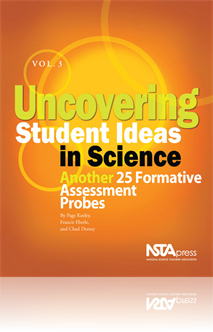All Book Chapters
Book Chapter
The purpose of this assessment probe is to elicit students’ ideas about growth. It can be used to determine whether students recognize that growth occurs as a result of cell division, which increases the number of body cells. Elementary school stud...
Book Chapter
The purpose of this assessment probe is to elicit students’ ideas about respiration. It is designed to find out whether students recognize respiration as a process that all living things use in order to obtain energy or whether they have a restrict...
Book Chapter
The purpose of this assessment probe is to elicit students’ ideas about decay and decomposers. It can be used to determine whether students recognize the need for a biological agent to break down once-living material as it uses it for energy. Eleme...
Book Chapter
The purpose of this assessment probe is to elicit students’ ideas about the cycling of matter. It can be used to determine whether students recognize that once-living matter breaks down and cycles through ecosystems without subtracting or adding ma...
Book Chapter
The purpose of this assessment probe is to elicit students’ ideas about an everyday object in the sky—clouds. It is designed to determine whether students recognize that clouds are made up of tiny droplets of water or tiny ice crystals. Elementar...
Book Chapter
Where Did the Water Come From?
The purpose of this assessment probe is to elicit students’ ideas about condensation. It is designed to determine whether students recognize that condensation comes from the water vapor in the air. Elementary students’ emphasis is on observing a...
Book Chapter
The purpose of this assessment probe is to elicit students’ ideas about precipitation. It is designed to determine whether students understand what causes the water in clouds to fall as rain. Elementary students’ emphasis should be on observing a...
Book Chapter
The purpose of this assessment probe is to elicit students’ ideas about seasons. It can be used to determine whether students recognize the effect of the Earth’s tilt on its axis and the resulting intensity of sunlight as the reason for seasons. ...
Book Chapter
The purpose of this assessment probe is to elicit students’ ideas about light and shadows. It is designed to find out students’ ideas about how shadows change throughout the day. Observing changes in shadows is a common activity for elementary sc...
Book Chapter
The purpose of this assessment probe is to elicit students’ ideas about stars. It is designed to examine students’ ideas about the location of stars in the daytime. Elementary students make observations of the day and night sky and question where...
Book Chapter
The purpose of this assessment probe is to elicit students’ ideas about solids. It is designed to reveal the macroscopic and/or microscopic properties students use to decide whether a material is a solid. Elementary school students describe the pro...
Book Chapter
This engaging lesson simultaneously involves animals, flowers, mathematical patterns, and art. Students will learn to discern between radial symmetry, bilateral symmetry, and asymmetry by observing and classifying objects, shapes, and photos and by d...
Book Chapter
Calculating the Speed of Sound
Who hasn’t seen a dramatic flash of lightning, only to hear the dramatic “crack” of thunder several seconds later? But why does the thunder reach our ears after we see the lightning? Or, why does the sound of a high-flying jet airplane passing ...
Book Chapter
Exploring the Dynamics of Temperature
Would your students like to take care of a penguin? To be a “penguinsitter,” they would have to know what conditions that bird needs to survive. One important factor would be temperature. In this activity, you will challenge student groups to pro...
Book Chapter
Observing the Effects of Acids and Bases
Combining acid/base chemistry, cell biology, and quantitative research methods, this “egg-ceptional” activity promotes a truly interdisciplinary perspective. First, students find out what effect acids and bases have on calcium-based substances su...



.jpg)